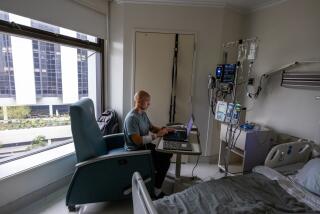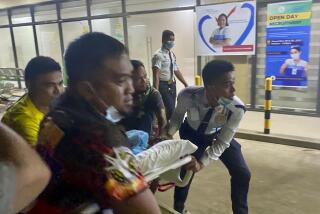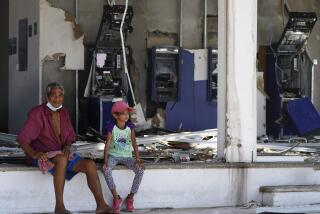Philippine typhoon: Tales of heartbreak, courage; hunger, anarchy
MANILA — Each story is more heartbreaking than the last; tales of the courage and good fortune it took to survive amid utter destruction, balanced in many cases by the last glimpse or word of a loved one who didn’t.
President Benigno Aquino III declared a “state of national calamity” Monday in an effort to speed up aid to islands of the central Philippines, ravaged by a monster typhoon. The death toll climbed slowly to 1,774, but it’s expected to rise to 10,000 or more as bodies are collected in the cities and relief teams are able to reach cut-off rural areas.
One aid official estimated that 10 million people had been affected by Typhoon Haiyan and that 2 million to 3 million of them were homeless.
Survivors took to the roads or looted shops in search of food and water. The main hospital in Tacloban, the principal city on the island of Leyte, was reported to have been crippled by a storm surge. Many people jammed the airport looking for assistance or a way out of the region.
“In the Philippines, we really have no point of reference for a storm like this,” said Joe Curry, country director for Catholic Relief Services. “We’ve had so many typhoons before, but nothing compares to how intense and devastating this is.”
A 44-year-old Tacloban high school teacher told local reporters how she abandoned her dying daughter in their house, which was razed by the storm.
“ ‘Ma, just let go. Save yourself,’ ” Bernadette Tenegra quoted her daughter as telling her. “I was holding her, and I kept telling her to hang on.... But she just gave up.”
Then there was Rogelio Mingig, 48, who told his wife to stay home with their 12-year-old son and year-old daughter because he thought it would be safer. But they were trapped by rising floodwaters.
“We found her embracing the children in one arm and grabbing onto the ceiling with the other,” he told the Philippine Daily Inquirer.
Several survivors told of desperately hanging on to posts for hours early Friday as one of the strongest storms on record pushed up water levels.
One, 21-year-old Emily Ortega, gave birth to a healthy daughter Monday in a makeshift medical center at the Tacloban airport. Erika Mae Karakot just wanted to get word out to her family that she was still alive.
Residents described their city as in a state of anarchy, with no functioning government and few police officers or soldiers to keep order. The mayor of Tacloban, Alfred Romualdez, a nephew of former first lady Imelda Marcos, had to be rescued from his roof.
There were widespread reports of looting, not only of food and drinking water, but also televisions and washing machines.
So far, Aquino has resisted calls to place Tacloban and other cities under martial law. But the president did order hundreds of additional law enforcement officials to the area.
“There are local governments that, due to the strength of the storm, broke down because their personnel and officials also became victims,” Aquino said in his address Monday night.
An international relief effort was gearing up, but it was a long way from meeting the needs of a region where an estimated 80% to 90% of the structures had been damaged or destroyed.
Relief efforts so far are concentrated in Tacloban, which has the largest airport in the area. C-130 cargo planes are making regular flights now, but they have yet to reach the more far-flung disaster areas.
The U.S. military, which assigned 80 Marines to relief operations Sunday, sent an additional 100 Marines and sailors to the Philippines on Monday. Defense Secretary Chuck Hagel also announced that the aircraft carrier George Washington, which was on a port visit to Hong Kong, was being dispatched immediately to the Philippine coast along with other warships.
A carrier positioned offshore will potentially give the U.S. the ability to ferry supplies to isolated towns, though only in small amounts because of the size and number of aircraft that can land on its deck. It will also allow the U.S. to move the badly injured aboard for immediate medical care.
Two U.S. military cargo planes carrying water, generators and a squad of Marines left Manila for Tacloban. Sgt. Ben Eberle, a Marine spokesman, said the effort was still focused on assessing the need, but should move in the next day to providing assistance.
“In the next 24 hours, there should be a significant increase in resupply for Tacloban,” Eberle said.
The U.S. Agency for International Development was sending 1,000 rolls of plastic sheeting, 10,000 kits of sanitary supplies and 55 tons of food, enough to feed 20,000 children and 15,000 adults for four to five days.
United Nations agencies, other governments and nongovernmental aid agencies offered financial assistance or supplies.
“I don’t believe there is a single structure that is not destroyed or severely damaged in some way — every single building, every single house,” Marine Brig. Gen. Paul Kennedy told reporters after a helicopter tour of Tacloban.
The city of about 220,000 people lies along the strait separating two islands. It was hit first by the typhoon sweeping in from the Pacific Ocean to the east and later by waves coming in from the west. Most of the deaths were caused by surges of seawater up to 13 feet high that witnesses described as more like a tsunami than a typhoon.
Filipinos and veteran aid workers alike were stunned by the level of destruction from the storm, called Yolanda in the Philippines.
“We have at least 20 to 26 typhoons a year, especially this time of the year. The storm surge in Tacloban, which is surrounded by water, that was the one thing we were not able to anticipate.... We never thought the effect would be that big,” said Maj. Gen. Raul Gabriel L. Dimatatac, vice commander of the Philippine air force.
“We’ve been battered over and over again by natural disasters,” said Natasha Reyes, emergency coordinator in the Philippines for the aid group Doctors Without Borders. “So when I hear about people being so desperate, so stunned, so hopeless, it really tells me just how bad this is.”
Days before the typhoon, there had been extensive warnings about its ferocity. Hundreds of thousands of people evacuated or reinforced their homes in preparation. But even emergency shelters in schools and concrete government buildings suffered extensive damage from the winds and floodwaters.
As aid workers began to reach Tacloban, many worried about what they would find when they finally got to more isolated areas.
Curry said it would take days to get aid from the airport into the countryside.
“We haven’t had any direct contact with people who are in these rural areas, who also took a direct hit, and what we’re seeing from the aerial shots is just complete and utter devastation,” he said.
“When you take someone who lives on day-to-day subsistence and you take away their food, they have nothing to eat,” he said. “No. 2, people need clean water.
“Imagine rural areas where people live in small villages, where everything is flattened, and there is debris everywhere,” he said. “People just need something over their heads to give them shade and give them a place to sleep at night. Right now, they probably don’t have that.”
Special correspondent DeLeon reported from Manila and Times staff writer Demick from Beijing. Staff writer David S. Cloud in Washington contributed to this report.
More to Read
Start your day right
Sign up for Essential California for news, features and recommendations from the L.A. Times and beyond in your inbox six days a week.
You may occasionally receive promotional content from the Los Angeles Times.






